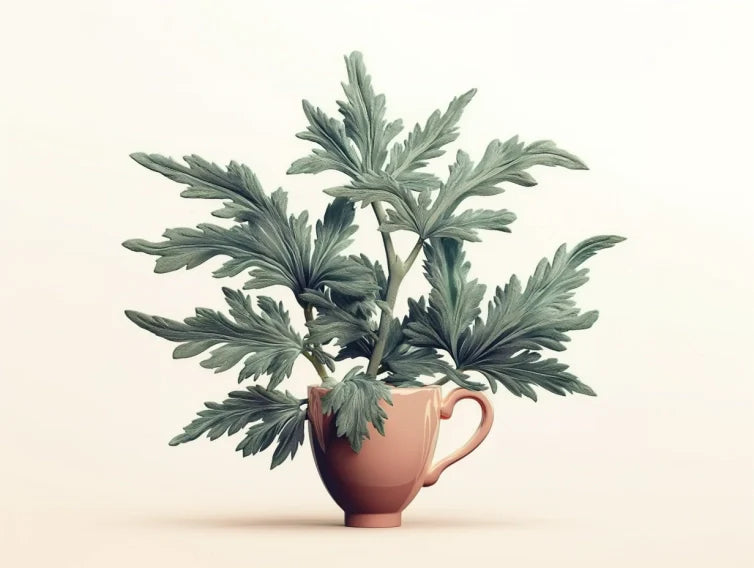Want to join the club?
Mugwort (Artemisia vulgaris) has been known for centuries in many cultures for its diverse therapeutic uses. In herbal traditions, it is known for promoting relaxation, boosting vitality, helping digestion, and easing menstrual discomfort. Its antioxidant and anti-inflammatory properties have also made it a key ingredient in modern skincare products.
Mugwort also plays a significant role in Traditional Chinese Medicine. It is used in moxibustion to stimulate the flow of qi and improve circulation.
Mugwort Benefits and Uses
Mugwort has been used for centuries in both traditional medicine and modern wellness practices. Below are some of its most notable benefits and applications. These are backed by historical use and emerging scientific insights.
1. Relaxation and Sleep Support
Mugwort contains natural compounds, such as flavonoids and coumarins, that may help calm the nervous system. It’s often used in teas or aromatherapy to promote relaxation and improve sleep quality. While scientific studies are limited, its long-standing use highlights its potential as a natural sleep aid.
2. Support for Menstrual Health
Mugwort is known to have muscle-relaxing properties. It has been traditionally used to ease menstrual cramps and promote healthy blood flow. It is thought to help relax uterine muscles and regulate cycles. This use is well-documented in both Chinese medicine and Western herbal traditions. This is one of the reasons that Mugwort is featured in our happy period formula.
3. Enhancing Dreams
Mugwort has earned a reputation as a “dream herb” in folk traditions. Burning mugwort or placing it under a pillow is said to enhance dream vividness and recall. This effect may be due to the presence of a psychoactive compound called thujone. This compound is only present in small amounts.
4. Skin Health
Due to its anti-inflammatory and antimicrobial properties, there are many Mugwort benefits for skin. It is used to soothe irritation, reduce redness, and combat dryness. Some scientific studies suggest that it has an antioxidant-rich profile. This can protect skin cells from environmental damage, making it beneficial for sensitive or acne-prone skin. Mugwort-infused oils and essences are especially popular in Korean skincare products.
5. Digestive Aid
As a natural bitter herb, mugwort can support digestive health. It does this by stimulating bile production and digestive enzymes. These actions aid in breaking down fats and improving nutrient absorption. Mugwort is also mildly carminative, meaning it helps alleviate gas and bloating. This makes it a useful herb for gastrointestinal discomfort.
6. Mugwort in Moxa (Moxibustion)
Mugwort is central to moxibustion, a traditional Chinese medicine practice in which dried mugwort is burned near acupuncture points. This is done to stimulate energy flow and promote healing. The heat generated by moxa is believed to enhance circulation, reduce pain, and boost overall vitality. Moxibustion is commonly used to address cold conditions and digestive issues. It can even help to turn breech babies during pregnancy.
7. Energy and Stress Management
Mugwort is known for its adaptogenic-like properties. This makes it a helpful herb for managing stress and maintaining energy. Traditional use suggests it may help the body adapt to physical and mental stress, though scientific studies are limited.
8. Smudging and Ritual Use
Burning mugwort as a smudge has long been practiced for spiritual cleansing and focus. It’s believed to ward off negative energy and create a calming atmosphere, making it popular in meditation and rituals.
9. Mugwort in Smoking Blends
Mugwort is often included in herbal smoking blends. It is known for its smooth, aromatic smoke and calming effects. Smoking mugwort is used as a tobacco alternative or as part of ritualistic practices. While its historical use as an herbal smoke is well-documented, it’s important to approach any form of smoking with caution due to potential respiratory impacts.
Mugwort Varieties: From East to West
The Artemisia genus includes more than 200 species, known for medicinal, culinary, and spiritual uses. Below are the most notable varieties:
1. Common Mugwort (Artemisia vulgaris)
• Region: Native to Europe, Asia, and North America.
• Uses: Common mugwort is the most well-known species and widely used in herbal medicine. It's used for its calming, digestive, and menstrual-supportive properties. It is also burned in rituals to enhance dreams and is a key ingredient in teas and herbal smoking blends. This is the type that we use in our products.
2. Chinese Mugwort (Artemisia argyi)
• Region: Predominantly found in China and other parts of East Asia.
• Uses: A cornerstone of Traditional Chinese Medicine (TCM). Chinese mugwort is most famous for its role in moxibustion. This where dried mugwort is burned to stimulate acupuncture points and improve circulation. It is also brewed into teas or included in soups to support digestion and respiratory health.
3. Western Mugwort (Artemisia ludoviciana)
• Region: Native to North America, particularly in the Great Plains and Southwest.
• Uses: Often used in smudging rituals for its lighter, floral aroma and spiritual cleansing properties. Indigenous peoples have traditionally relied on western mugwort for treating colds, fevers, and wounds. It is also used as a digestive and menstrual support herb.
Additional Mugwort Varieties
• Japanese Mugwort (Artemisia princeps): Popular in skincare and cuisine.
• California Mugwort (Artemisia douglasiana): Known for spiritual cleansing and Indigenous medicinal uses.
• Wormwood (Artemisia absinthium): While not technically mugwort, wormwood is a close relative. It is best known for its use in absinthe and its bitter, digestive-supporting properties.
Do you use any of these mugwort varieties? Maybe now is the time to start!



